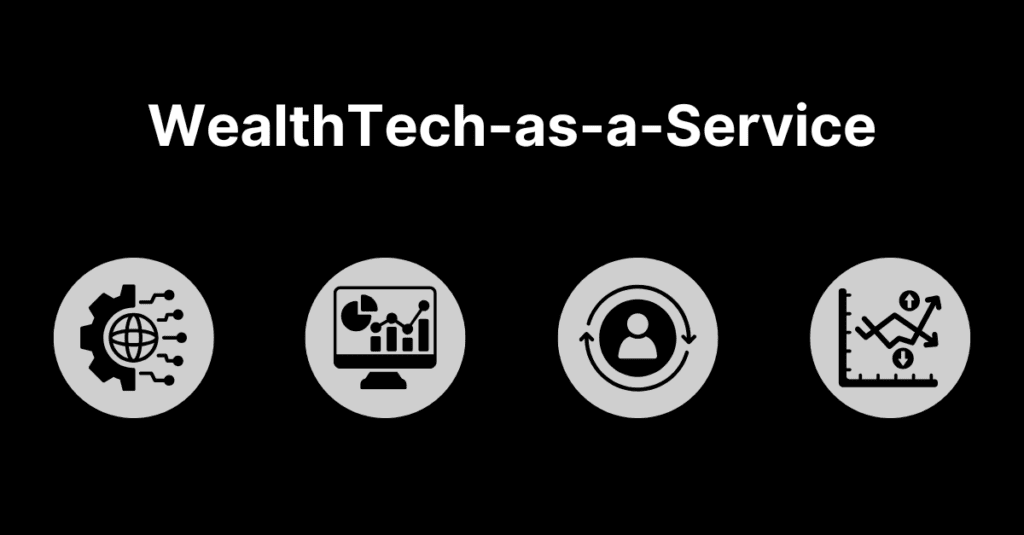“WealthTech-as-a-Service” (WTaaS) describes the blend of wealth management and essential technology available through a range of cloud-native, API-first data and application infrastructure softwares which help wealth management firms and fintech innovators power differentiated applications and digital experiences through a consumption-based model–removing the need for costly capital expenditures and in-house software development overhead. WTaaS’ on-demand accessibility, scalability, and cost-effectiveness make it an appealing option for both fintechs and established financial institutions seeking to enhance operational and technical efficiency, modernize their tech stack and improve their overall customer experiences.
“As-a-Service” business models have risen in popularity during the Internet age and describe cloud technology—usually software-–that one company licenses to others for a subscription-based fee. Companies that purchase a subscription enjoy reduced upfront IT spending while also getting to access the latest technology without the ongoing costs and tech burden. Many of the world’s largest tech companies sell “As-a-Service” products:
- Shopify: Ecommerce-as-a-Service
- Slack: Communication-as-a-Service
- Amazon Web Services: Cloud-Computing-as-a-Service
With the SaaS model, if you want to start an online business, you no longer need to code your own online store from scratch. Instead, you can leverage Shopify via a monthly fee to access their pre-built eCommerce infrastructure for key components such as inventory management, embedded payments, shopping cart management and much more. For entrepreneurs, the small monthly fee is well worth the benefits (minimal to no coding, consistent website upgrades, tech support from Shopify, integration with other tools, etc.). While many industries have seen a rise in these types of offerings including platform-as-a-service (PaaS) and even Infrastructure-as-a-service (IaaS), BridgeFT is the first to introduce the “As-a-Service” model to the wealth management market.
Through its WealthTech-as-a-Service API-first solution, BridgeFT supplies clients with financial data infrastructure, analytics and application services. This allows firms to focus on customizing their own user experience instead of on building the core “pipes” related to multi-custodial data infrastructure, application business logic, complex calculations and even client-ready output. In this sense, BridgeFT is doing for wealth management what Shopify has done for eCommerce.
Let’s dive into the specifics of WTaaS and how wealth management firms of all sizes are leveraging it to build and scale wealthtech applications more efficiently.
Benefits of WealthTech-as-a-Service
WealthTech-as-a-Service is making it easier and cheaper for fintechs and financial institutions to build complex financial applications and solutions. In this sense, it’s leveling the playing field for companies of all sizes and business models.
Here are just a few of the benefits of leveraging WTaaS:
- Less time spent building infrastructure: Firms like BridgeFT have already done the heavy-lifting to create a best-in-class data and application infrastructure in the cloud. This allows their clients to focus on providing products/services and experiences that differentiates their business, not on developing and managing software that does not add value to their growth objectives.
- Access to comprehensive, analytics-ready data: Core to any modern wealthtech application is the data that connects clients and their investment accounts. BridgeFT offers a single, standard data model for multi-custodial data, helping provide real-time, up-to-date client investment account data–all through APIs for easy connectivity.
- Cost savings: WealthTech-as-a-Service significantly reduces costs by up to 50% when compared to building a new application from scratch. This also includes eliminating upfront hardware costs, reduced technology resource overhead and ongoing maintenance costs.
- Cloud-native: BridgeFT’s WealthTech API is cloud-native in AWS, which provides scalability, increased security and unit economics.
- API-first: BridgeFT is built by developers, for developers. Its platform includes comprehensive API documentation, how-to recipes and code snippets, and developer-to-developer support.
One of the most common reasons that financial institutions partner with a WTaaS provider is that it eliminates the time, manpower, and financial resources that are traditionally required to build a custom wealthtech application.
Before WTaaS, building a custom wealthtech application involved a host of challenges– from building one-off custodial data interfaces either directly or using a legacy aggregator, to licensing and integrating market data services, and finally building core services with business logic, calculations, and analytics—all to then connect it to a user interface that may our not be custom to your business needs. However, BridgeFT has simplified this process by removing all of these roadblocks for its clients. Now, clients can focus purely on building unique, high-impact digital advisor-client experiences.
A wealth management company leveraging BridgeFT is similar to an apparel company using Shopify to power its website. Why spend months building a custom website from scratch when you can just leverage best-in-class application building blocks that offer much more flexibility in how you deliver products/services, all for an affordable monthly subscription?

Who Can Benefit From WealthTech-as-a-Service?
All enterprises interested in developing wealthtech applications can benefit from WealthTech-as-a-Service. This includes:
- Wealth Management Application Providers (WealthTechs): Leveraging WTaaS is valuable for both startups and mature wealthtechs as it lets them focus on building a unique, high-quality customer experience.
- Turnkey Asset Management Platforms (TAMPs): Again both new and established TAMPs have a need for WTaaS as they look to scale, expand available functionality, and/or create a truly one-of-a-kind advisor experience that enables technology to be their differentiator.
- Investment Product Distributors: Asset managers, insurance carriers, alternative investment platforms, and emerging investment product distributors all have a need for WTaaS to help create technology-enabled investment product distribution through a modern experience that they have total control over.
- Startups/Entrepreneurs: The infrastructure that’s needed to power new wealthtech apps has already been created. This allows smaller firms without big budgets to create and launch their own apps without worrying about significant funding and resources.
- Established Firms: WTaaS isn’t only for startups. This revolutionary tech has created an opportunity for larger companies to redeploy assets and maximize profitability.
WealthTech-as-a-Service is helping firms create customizable experiences for end users at scale, beyond what any traditional WealthTech has done before.
Why Change?
Companies that have been in business for decades might be hesitant to switch to a new platform. After all, why make a change when the old way has worked so well?
There are two main reasons why wealth management companies are switching to WealthTech-as-a-Service in droves:
- Rise of Digital: In today’s world, the average consumer carries what would have been considered a supercomputer just a few decades ago. Accordingly, firms need to leverage technology to develop more of their own applications and experiences to differentiate their offering from others on the market. This is no longer an option, it’s a must-have.
- Access to Data: Current, siloed applications don’t address the modern workflow of financial services firms and are not flexible enough to enable firm-specific use cases, therefore wealth technology providers will need to adjust their application approach. For example, customers will come to expect real-time updates that only intraday wealth management data sources can provide.
As an example, with the emergence of WTaaS, wealth management providers can finally unlock the power of multi-custodial data to propel their enterprises forward – all without the limitations typically put in place by direct one-off custodial feeds.
To delve deeper into the factors driving the rise of WTaaS, you can check out BridgetFT’s CEO Joe Stensland’s interview with FintechTV.
How Do Firms Build a WealthTech Infrastructure?
When it comes to building a WealthTech infrastructure, firms have the option to build a solution internally or outsource.
1.) Internal Development:
Building a custom internal solution will ensure that the company can build it exactly to fit its specifications. However, this approach also requires an extensive investment of time and resources. This capital output is likely outside the realm of possibility for many companies.
Additionally, existing development teams might not have the required skillset or bandwidth to build what is needed. If this is the case, the company would have to hire additional product experts and engineers.
Another factor to mention is the ongoing maintenance required to keep data feeds accurate and timely, as well as updates to keep applications relevant to business and client needs. Organizations that develop financial data infrastructure in-house must have dedicated staff to update and maintain those applications and data feeds going forward.
2.) Traditional Legacy Provider:
Outsourcing the development of WealthTech infrastructure to a traditional legacy wealth management data aggregation provider, or buying a solution ‘off-the-shelf’ is the next most common method.
While this can be a better option than developing an internal solution, legacy data aggregators and all-in-one solution providers typically use outdated processes and file types which tend to be time-consuming, manual, and at risk of failing. This puts data timing and accuracy at risk.
Additionally, traditional legacy wealth management providers are known for offering a one-size-fits-all solution. This may not be a good fit for companies with unique needs, or who don’t want to pay for extra software functions they do not need or want to use.
3.) WTaaS: The More Modern Way to Build WealthTech Infrastructure
The third and final approach to building WealthTech infrastructure is to leverage the value and full capabilities of WealthTech-as-a-Service.
With WTaaS, wealth management providers can simply leverage the broad range of cloud-based data, advanced analytics and application services infrastructure that’s provided by companies like BridgeFT.
With WTaaS, both emerging and established wealthtechs and financial institutions can focus on building the best user experience possible, while knowing that their back-end data will be supplied in a timely manner.
BridgeFT: The WealthTech Behind Leading WealthTechs
There’s a good chance that you’re familiar with one of the many leading wealthtechs and enterprise wealth management firms whose technology is supported by BridgeFT’sWealthTech API. This includes innovative companies like Dynasty Financial Partners, VRGL, Zoe Financial, SmartRIA, Flyer Financial Technologies, and Income Lab, among others.
BridgeFT’s WealthTech API is the industry’s leading WealthTech-as-a-Service offering, and it’s helping to change the wealth management industry in unprecedented ways that accelerate application development, reduce ongoing technology costs, and improve the overall digital experience for advisors and clients alike.
BridgeFT’s WTaaS solution provides critical data and application services through a single API platform that is more efficient and economical than traditional offerings across the wealth management landscape.
Find out more about what BridgeFT’s wealthtech-as-a-service can do for your business.

